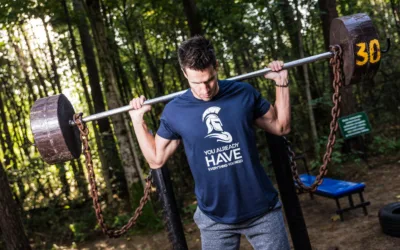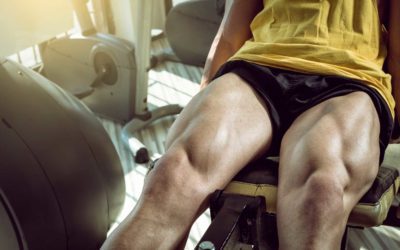Best Olympic Weightlifting Program For Beginners
TOPIC: Selects | Strength & Conditioning
Have you ever wanted to lift weights like an Olympian? Then today’s your day because, in this article coach, Mike Dewar shares a basic template for beginner and intermediate athletes on how to build in Olympic weightlifting program!
This is THE best free guide to Olympic Weighlifting available, so whether you’re looking for a sample program or just a new strength program to try, save this post and keep it handy as you start your training!

Written By
Mike Dewar
Mike holds a Masters in Applied Physiology from Columbia University and a Bachelors in Exercise Science from Bowling Green State University. He is an accredited Strength and Conditioning Specialist (NSCAS CSCS) from the National Strength and Conditioning Association and an Advanced Sports Performance Coach from USA Weightlifting (USAWL2).
Programs
Website
How To Build An Olympic Weightlifting Program
One of the great things about being a coach is the ability to impact the lives of your athletes and clients.
After the initial meet and greet with a new athlete, you are often bombarded with questions like:
– How does your system work?
– Is it OK for beginners?
– What are some things a beginner needs to do to get started?
In this article, I wanted to share a basic “free template” on how to build an olympic weightlifting program geared toward the beginner and intermediate individual that walks into your weightlifting club looking to become more fluent in the lifts, gain strength, and set a strong foundation for years to come.
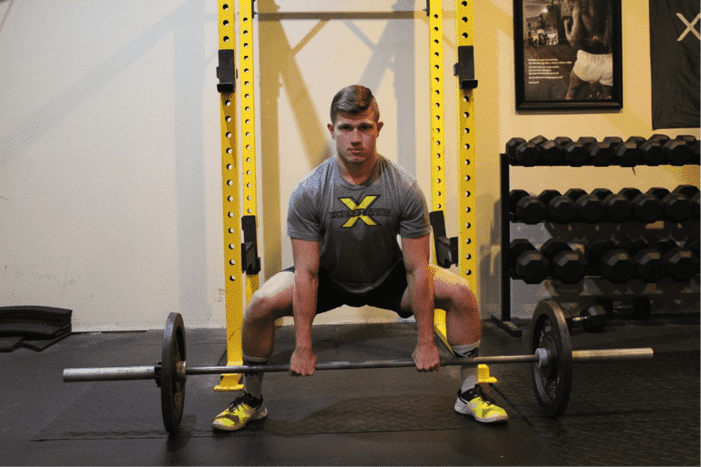

Who Are Beginners In Weightlifting?
When meeting a new athlete, I find it best to assume that they are a beginner, and go from there.
Often, this is the case with most individuals, despite having some experience performing power cleans or snatches in sports training or other fitness classes.
There are instances where someone will let you know their history with olympic weightlifting, and they may fall outside the “beginner” constructs, which I have loosely listed below.
In the event that you have someone who is past the beginner stages, I have also found that the below plan is still effective and can be used to set the outline for their training.
Beginner athletes are often anyone with less than 6 months of formalized Olympic weightlifting programming.
This may include individuals who transition from sports training or CrossFit.
It is important to recognize that a basic understanding of the movements and basic athleticism, while necessary, may not in fact allow someone to surpass this beginner phase.
Too often coaches assume since an athlete is strong (squats heavy, can press a lot, and moves well) that he/she can begin training in a more rigorous cycle.
Be careful not to make this mistake. I find it best to include these athletes, and everyone else with under 6 months of formal lifting experience, in the beginner bin.
As athletes train more you will be able to quickly progress lifters based on performance.
Defining Olympic Weightlifting Classes
Another way to classify lifters (which I like to combine with the above loose guidelines) is to compare them with the standards found in “Weightlifting Programming: A Winning Coach’s Guide” by USA Weightlifting coach and author, Bob Takano.
Classifying athletes based on their abilities (in this case their snatch and clean and jerk total) allows you to look at the athlete from a 100% sport-specific lens.
For example, if you had a novice weightlifter come to you with a 400lb squat, but could only snatch 135 lbs, you would have to quickly assume their technique, mobility, and olympic weightlifting experience is not correlated with their strength.
By using the below guidelines, you can take a more sport-specific approach to classifying athletes specific to the sport of olympic weightlifting.
In the below charts, you will find the exact classification system used to rank and access an athlete based on performance.
For the nature of this article, we will only be concerned with athletes who fall within the Class 3 and 2 (III and II). Note that Class 3 is the lower level athlete. As an athlete progresses, they will move down the list.
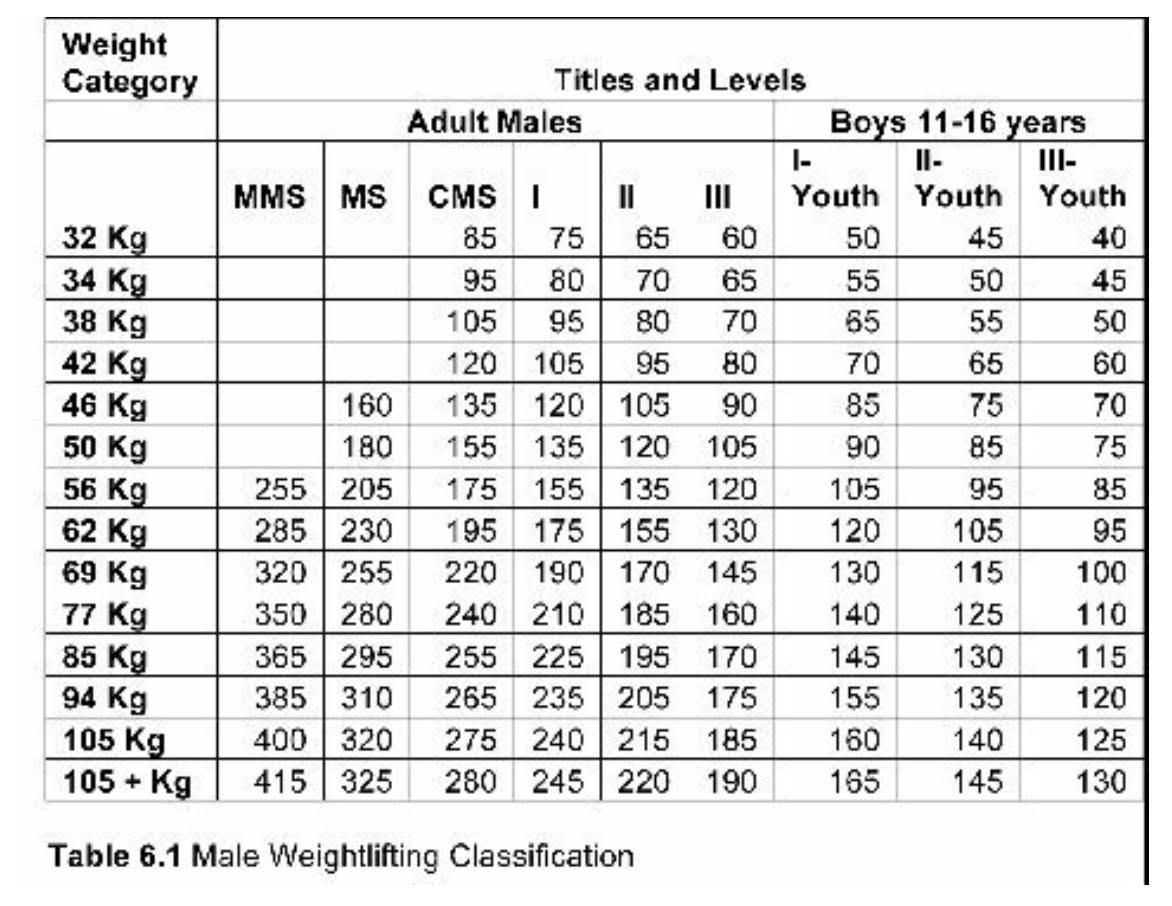

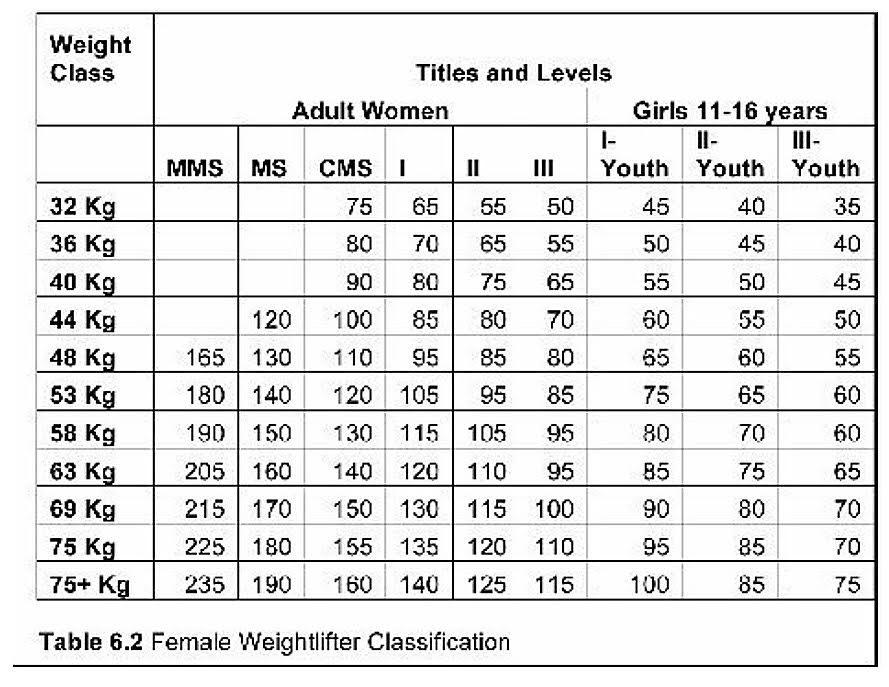

Class III
NOVICE (This classification of lifters includes anyone with a total – snatch + clean and jerk – equal to or below the standards in the table below.)
CLASS II
NOVICE – INTERMEDIATE (This classification of lifter is still considered a beginner, but will have some basic understanding of the movements, some skill and technique, and basic strength. Often, beginner athletes lack speed and timing, and therefore, should still fall within a “beginner” classification.)
CLASS I
Candidate for Master of Sport Training (CMS)
Master of Sport Training (MS)
International Master of Sport Training (IMS)
The 8 Goals Of An Olympic Weightlifting Program
In this section we will discuss the primary goals of the beginner Olympic weightlifting program, which should help coaches understand the long-term approach that should occur when working with a beginner lifter.
In this section we will discuss the primary goals of the beginner Olympic weightlifting program, which should help coaches understand the long-term approach that should occur when working with a beginner lifter.
1. GENERAL PHYSICAL PREPAREDNESS (GPP)
Building a basic level of fitness is key for long-term growth and injury prevention.
Adding some basic plyometrics, strength, and corrective/accessory exercises within each session can really help to diversify a beginner athlete’s movement and health.
2. MOBILITY AND FLEXIBILITY
Addressing any mobility and flexibility issues is key when starting out.
While many beginners may lack control and basic flexibility in some positions, most of them can actually increase mobility by simply doing the movement. With that said, if there are structural blocks in movement, such as bone on bone or scar tissue, more advanced care should be given.
Be sure to team up with a qualified sports physical therapist and doctor to best diagnose and assess new athletes.
3. TECHNIQUE AND TIMING OF THE LIFTS
The need for proper timing and technique is paramount during this stage. Many lifters will want to lift heavier than they should (and some coaches are too eager as well).
Skill development is key in this phase, so learn heavier lifts – the squats, presses, and deadlifts (which should still be done with great form to best transition to the Olympic lifts).
4. MUSCLE HYPERTROPHY
Building more muscle tissue is so important during this phase (and throughout an athlete’s lifting career) to give them the raw material they need to become more powerful and stronger.
Without proper muscle hypertrophy training, many athletes will lack long-term growth in strength and performance.
5. NEURAL ADAPTATIONS
Weightlifting is a very neurologically challenging sport, in which the new lifter must become adapted to moving with high motor control under high amounts of loading during velocity-based movements.
The need for speed and strength, while moving in very precise patterning, requires a beginner athlete to develop better neurological connections and impulses throughout their careers as weightlifters.
6. BUILD A BROAD EXERCISE AND SKILL TOOLBOX
While you do not want to overwhelm the lifter with a million exercise variations, you do want to expose them to a good amount of exercises so they can build out their movement patterning, coordination, and understanding of the lifts.
This can be done by adding more training days (as long as you drop the overall volume across the week…see below video and sections), adding complexes, or simply having a more long-term beginner phase timeline.
7. DEVELOP WORK CAPACITY
Work capacity, or conditioning, is a term that describes an athlete’s ability (cardiovascular and muscle endurance) to train with increasing amounts of load and volume without diminished quality of work and excess fatigue. Some beginners will be better at this than others.
By increasing training volume, moderating rest periods, and adding in accessory and fitness movements, you can work to increase their basic fitness so they can participate and progress in more rigorous training cycles.
8. POSITIVE TRAINING OUTLOOK / ENJOYMENT
The coach must understand that most beginners that come to you are also looking to participate in weightlifting for the mental and fitness benefits.
Making sure to monitor fatigue, building a strong relationship, and staying positive (even when your athletes are beat) is key to helping beginners transition into long-term lifters.
Example 4 Week Olympic Weightlifting Program
The easiest way to start this conversation is to first lay out a sample program for beginners that focuses on the most important training outcomes discussed above.
In the below video I demonstrate how quick and easy it is to use software like TrainHeroic to create, share, store, and sell online training programs for your athletes, clubs, and team.
Below is the complete first week of a sample 4-week program, which is walked through in the above video.
Note that this is geared for entry level lifters who still have some basic understanding of body movement and mobility.
Simple progressions from week to week can be made by increasing intensities by 2-3% each week, or simply allowing lifters to master a given load week after week (for the first 3-4 week cycle).
Below is the complete first week of a sample 4-week program, which is walked through in the above video.
Note that this is geared for entry level lifters who still have some basic understanding of body movement and mobility.
Simple progressions from week to week can be made by increasing intensities by 2-3% each week, or simply allowing lifters to master a given load week after week (for the first 3-4 week cycle).
DAY 1
- Squat Jump 3×8 at 20% squat RM
- Block Power Snatch 5×3
- BTN Snatch Push Press 3×5
- Squat 3×5 at 70% squat RM
- Strict Pull Up 4×8
- Seated Overhead Press 4×8
DAY 2
- Box Jump 3×8
- Muscle Clean 5×3
- Power Jerk 3×5
- Block Snatch Pull 3×5
- Belt Squat 3×12
- Single Leg RDL 3×12
DAY 3
- Split Squat Jumps 3×5/leg (10 total)
- Snatch High Pull + Muscle Snatch + Overhead Squat 5×2+2+1
- Drop Snatch 3×5
- Front Squat 3×5
- Single Arm Dumbbell Row 4×8
- Dips / Push Ups 4×8
DAY 4
- Box Jump 3×8
- Block Power Clean 5×3
- Push Press 3×5
- Clean Deadlift 3×5
- Walking Lunge 3×20 steps
- Waiters Carry 3×20 steps
5 Key Variables In Olympic Weightlifting
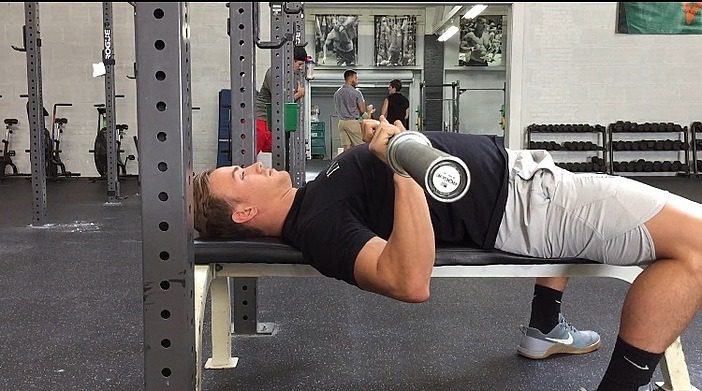

Below are some of the key ones coaches should monitor and manipulate, with recommendations on how to specifically do so for beginner Olympic weightlifters.
FREQUENCY
Frequency simply refers to the amount of training sessions in a given week.
While elite athletes are often seen doing 8-10 training sessions per week (often as two-a-day sessions), most beginners will not need, nor should participate in programs like this. Rather, shooting for 3-5 training sessions per week is most likely the ideal frequency to allow for skill development, strength and muscle mass acquisition, and adequate recovery.
By adding in active recovery days or rest days, you help an athlete also learn about the keys of rest, sleep, stretching, and nutrition, which are extremely critical once they become more advanced in the sport (CMS and higher).
INTENSITY
Intensity refers to the amount of loading (weights used) relative to an athlete’s maximum (1RM).
In beginners, you may not necessarily have a good grasp on their taxes (especially in more skill-based movements like the snatch and jerk) and therefore may need to use other methods for assessing exertion, such as your level of coaching experience, subjective rating systems (RPE, Rate of Perceived Exertion), or simply playing it safe.
In beginner stages the focus should not be on moving heavy weights slowly, even for strength work, but rather moving with integrity, positional awareness, and control.
For the skilled movement like snatch, clean, and jerk, it is vital that lifters develop a sense of timing and precision with the barbell at increasingly faster velocities.
Be sure to watch lifters who add loads to the barbell and have a chronic issue of slow barbell accelerations. This could be a sign that they are not developing the power tendencies or skill necessary for intermediate and advanced stages.
If this is the case, simply drop the load to a weight in which they can do satisfactory lifts, and work there for however long it takes to be consistent.
VOLUME
Training volume can simply be described as the total amount of loading across the entire session, week, and cycle.
This is often roughly calculated by multiplying the amount of sets and repetitions together, sometimes reflected into a “k-value,” which was introduced in American weightlifting by Carl Miller in 1974. Many weightlifting manuals have given recommendations on how to use this value. You can read more about how to calculate and use the k-value in Bob Takano’s article published in the National Strength and Conditioning Association Journal.
With that said, using “k-values” has its limitations (it’s time consuming, can be hard to use with beginners, and was established in Bulgarian systems where other performance variables also may have influenced recovery, training, etc., like large homogeneous gene pool to choose from, performance training centres for all athletes, performance enhancing drugs, etc).
Therefore, I find it best to follow general guidelines in the beginning phases similar to most progressive overloading models that increase volume at constant intensities, then drop volume to allow for increased intensities over time, followed by a short-term drop in volume and intensity to allow for supercompensation prior to a new cycle.
The key to remember is that most athletes in the beginning stages will not have too many issues recovering (compared to the more advanced athlete).
Due to the total training loads and weights lifted by more advanced athletes, the neurological and physiological stimuli (even though they are more trained) can make fatigue much longer, making proper balancing of volume and intensity critical as a lifter progresses.
EXERCISE SELECTION
Exercise selection is key for beginner athletes so they can establish proper technique/movement skill and develop a wide skill set for years to come.
Depending on the school of thought, coaches often opt to teach the lift from the top down (blocks, hangs, powers, the full lifts, etc.) or from the bottom up (pulls, high pulls, muscles, powers, fulls, etc.).
Regardless, coaches must find what method works best for their philosophy and athletes and stick to a key set of movements that are the foundation for more advanced training.
As a lifter progresses, many of these variations and foundational movements are slowly removed so that the lifter snatches, cleans, jerks, power snatches/cleans, and presses on an almost regular basis (this is specific to CMS and above levels).
EXERCISE ORDER
Generally speaking, more skill- and power-based movements are placed earlier in a training session to allow an athlete to recruit muscle units in the least fatigued start as possible.
After skill and power work (including plyometrics), strength and accessory can then be performed. This will help to ensure proper form, technique, and neurological function since peak power output is the key.
With that said, in more advanced athletes (CMS and above) you will often see squats and heavy strength work done prior to the Olympic lifts, those helping the nerves improve stimulation of individual motor units.
30 Olympic Weightlifting Exercises For Beginners
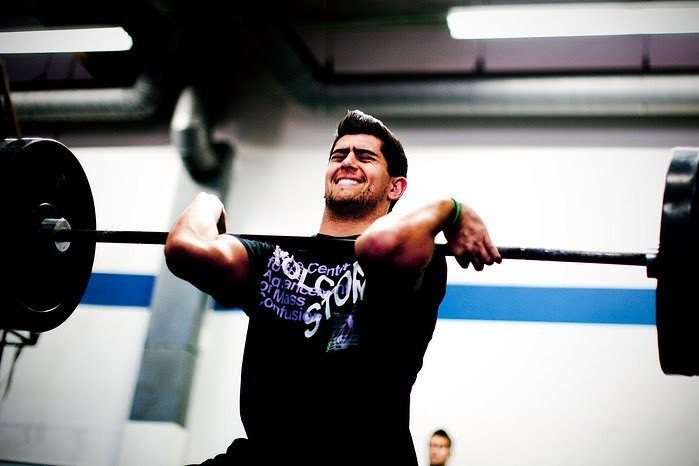

Below is a list of the main movements that should be included into most beginner Olympic weightlifting programs. (Developed by Bob Takano, and can be found in his book, “Weightlifting Programming: A Winning Coach’s Guide”
- Snatch
- Clean & Jerk
- Clean
- Jerk Off Rack
- Hang Snatch (from off the floor, below the knee, above the knee)
- Hang Clean (from off the floor, below the knee, above the knee)
- Power Snatch
- Power Clean
- Power Jerk (Snatch and Clean grip, in front of and back of the neck)
- Snatch Pull (or Extension)
- Clean Pull (or Extension)
- Back Squat
- Front Squat
- Romanian Deadlift
- Snatch Deadlift
- Clean Deadlift
- Overhead Squat
- Good Morning
- Presses (Jerk and Snatch Grips, in front of and back of the neck)
- Push Press (Jerk and Snatch Grips, in front of and back of the neck)
- Bench Press
- Seated Press
- Squat Snatch Press
- Jerk Balance
- Jerk Recovery
- Jerk Lockout
- Jerk Support
- Abdominal Work
- Hyperextensions
- Pull-ups
Find Your Perfect Training Plan
Sometimes all you need to reach your destination on your fitness journey is an expert guide. Look no further, we've got you covered. Browse from thousands of programs for any goal and every type of athlete.
Try any programming subscription FREE for 7 days!
Related Articles
You May Also Like...
Slow Reps vs. Fast Reps
You’ve probably noticed that some people in the gym tend to perform their reps as fast as possible, whereas others take a slow and controlled approach. But which is better? Dr. Andy Galpin is a Professor of Kinesiology at the Center for Sport Performance at California...
How to Do Leg Extensions Without a Machine
Short shorts are the new stinger tanks. Rocking those big tree trunks with canyon deep cuts is so hot. Leg extensions are a bodybuilding staple—they isolate your quads, the front-facing muscle group of your thighs, by flexing (bending) and extending (straightening)...
Tried-and-True Methods to Fix Plantar Fasciitis
What is Plantar Fasciitis? If you’re new to running or returning to it after a break, you might have been blighted by plantar fasciitis, a fancy name for an annoyingly common foot problem. It’s when the band of tissue that connects your heel to your toes (the plantar...
Slow Reps vs. Fast Reps
You’ve probably noticed that some people in the gym tend to perform their reps as fast as possible, whereas others take a slow and controlled approach. But which is better? Dr. Andy Galpin is a Professor of Kinesiology at the Center for Sport Performance at California...
How to Do Leg Extensions Without a Machine
Short shorts are the new stinger tanks. Rocking those big tree trunks with canyon deep cuts is so hot. Leg extensions are a bodybuilding staple—they isolate your quads, the front-facing muscle group of your thighs, by flexing (bending) and extending (straightening)...


Want more training content?
Subscribe
For Coaches
For Athletes
About
Support
Training Lab
Access the latest articles, reviews, and case studies from the top strength and conditioning minds in the TH Training Lab!
Made with love, sweat, protein isolate and hard work in Denver, CO
© 2024 TrainHeroic, Inc. All rights reserved.
